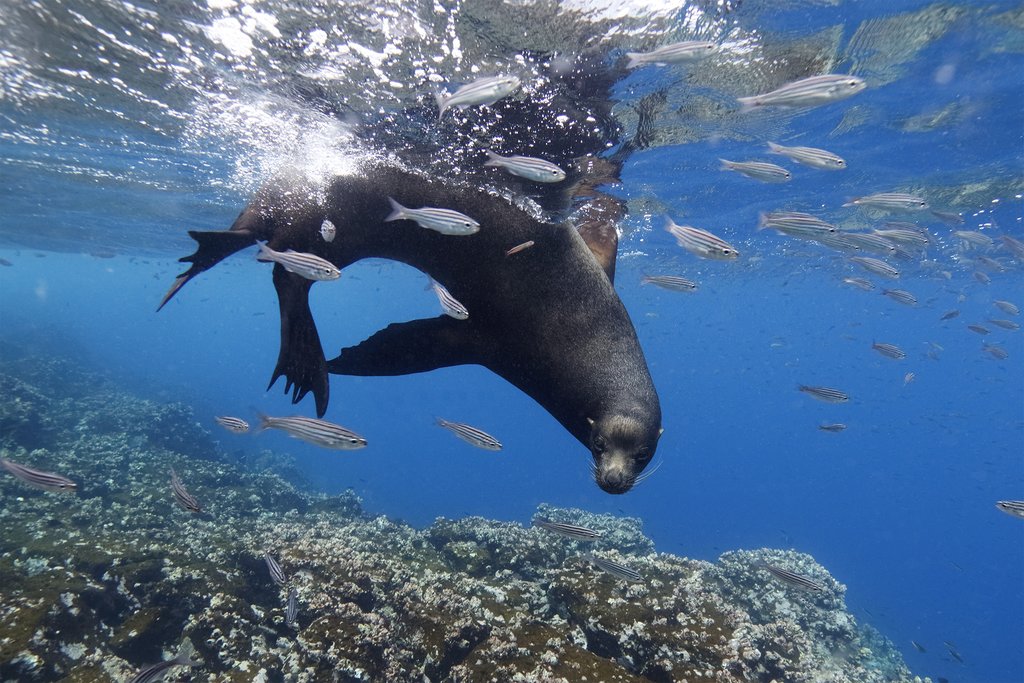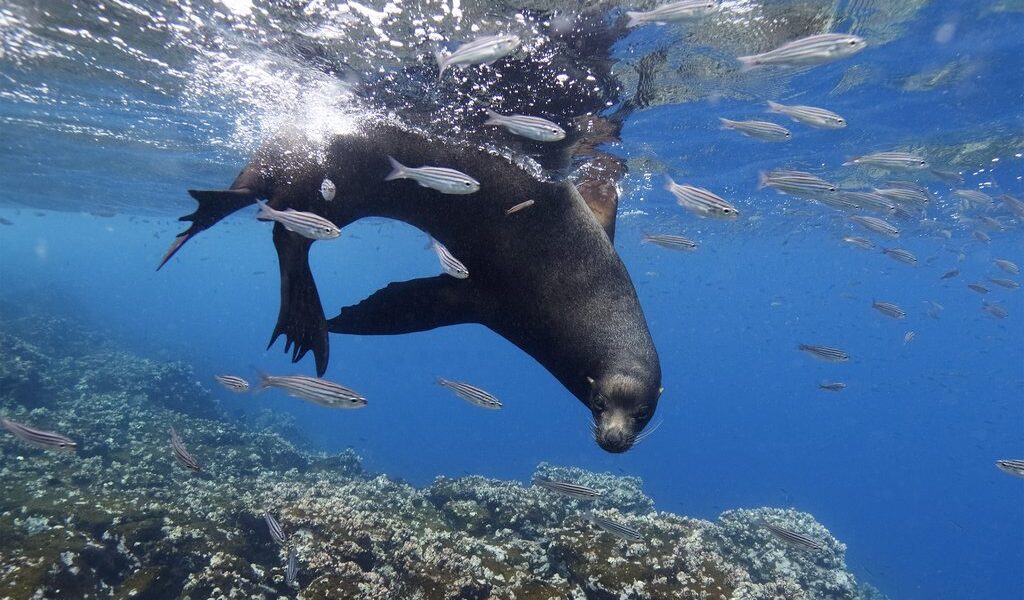
Traveling to Galapágos Islands in March means excellent wildlife watching and clear water visibility. It is one of the warmest months, which makes it the perfect time to enjoy snorkeling and visit the western islands. Many bird species are in the midst of their nesting seasons, and you can spot waved albatross and male frigate birds as they dazzle prospective mates with raucous displays. The renowned Holy Week starts towards the end of the month, where you can enjoy parades, food, and a vibrant atmosphere. Read on to find out more about visiting the Galápagos in March.
## Weather in the Galápagos Islands in March
March in the Galápagos Islands marks the heart of the wet season, with rainfall reaching its peak during this month. Travelers should anticipate more frequent showers and a generally higher level of humidity compared to other times of the year. The air can feel quite hot and heavy, creating a tropical atmosphere across the archipelago. Interestingly, the western islands, including Baltra Island, Genovesa Island, Santiago Island, Fernandina Island, and Isabela Island, tend to experience warmer temperatures than usual during this period. This localized warming effect makes these islands particularly appealing to certain wildlife and offers unique opportunities for observing their behavior.
Daily temperatures typically range from a comfortable 80 to 88 degrees Fahrenheit, providing pleasant conditions for exploring the islands. The ocean water maintains a temperature of around 79 degrees Fahrenheit, making it ideal for swimming, snorkeling, and diving. To minimize exposure to the heaviest downpours, planning your trip towards the end of March is advisable, as the rainy season begins to taper off. However, the increased rainfall can sometimes lead to sea surges, potentially affecting inter-island travel, especially on cruise ships. These surges are primarily observed around North Seymor Island and Gardner Bay, so travelers should be prepared for possible itinerary adjustments.
## Crowds and Costs in March
One of the significant advantages of visiting the Galápagos Islands in March is the lower number of tourists. This month generally sees fewer crowds, resulting in more tranquil and intimate experiences at popular visitor sites. As a result of the decreased demand, prices for accommodations and flights often experience a notable decline. For budget-conscious travelers, March presents an excellent opportunity to explore the islands without breaking the bank. While prices may gradually increase towards the end of the month as Easter and spring break approach, the overall cost remains relatively lower compared to peak season.
To truly avoid the majority of tourists, consider planning your visit for the early or mid-March. Despite the wetter weather, the Galápagos Islands offer a plethora of captivating sights and activities during this time. With fewer people around, you’ll enjoy a greater sense of privacy and be able to connect with the unique environment on a deeper level. Embrace the lush landscapes and abundant wildlife without the distractions of large crowds.
## Where to Go in March
March is a particularly rewarding time to witness the vibrant wildlife of the Galápagos Islands. Many land birds, sea lions, turtles, and tortoises enter their breeding or nesting season during this month, creating abundant opportunities for wildlife observation. The islands transform into a tapestry of blossoming flowers, providing a stunning backdrop for these natural events. Notably, March marks the return of the waved albatross to Española Island, and if you visit towards the end of the month, you might catch a glimpse of these magnificent birds.
Penguins are also readily observed in March, especially on Isabela Island and Fernandina Island. Keep an eye out for these charming creatures as they navigate the rocky shores and swim in the cool waters. On San Cristobal and Genovesa Island, frigate birds commence their elaborate mating rituals, showcasing their distinctive puffed-out pouches. If weather conditions permit, consider taking a boat cruise to North Seymour, where you can witness marine iguanas nesting in March, a truly remarkable sight.
In general, the warmer weather on the westernmost islands during March makes them an appealing destination, as they tend to remain cooler for the rest of the year. Take advantage of the pleasant temperatures to explore these unique ecosystems.
## What to Do in March
March is an exceptional month for observing nesting birds and animals in the Galápagos Islands. Green sea turtles, marine iguanas, and land iguanas are all actively engaged in their nesting season. During this period, the female land iguanas can become more territorial and protective of their nests, so it’s essential to maintain a respectful distance. Witnessing sea turtles emerging from the ocean to lay their eggs on the sandy beaches is a truly unforgettable experience.
Bird enthusiasts will be thrilled by the frigate birds nesting activity, particularly on Genovesa Island. Other bird species that nest during this time include penguins, flightless cormorants, and greater flamingos. March also offers a higher-than-average chance of spotting rare baby giant tortoises, which are still hatching during this month.
The predominantly sunny days, coupled with the inviting warm waters, make March an ideal time for snorkeling with playful sea lions and hiking past colonies of blue-footed boobies. To enjoy breathtaking panoramic views after the rainfall, venture to Punta Vicente Roca Isabela for hiking.
## Events in March
A significant cultural event that takes place in March is The Holy Week. Beginning between March 19th and March 22nd, this Catholic holiday is one of the most important celebrations in both the Galápagos Islands and mainland Ecuador. The Holy Week commences with Palm Sunday and culminates on Easter Sunday. The celebrations are elaborate and vibrant, featuring parades and daily processions in every major town.
## Traveling to the Galápagos Islands in March?
Consider exploring itineraries focused on land-based adventures for a comprehensive experience of the islands’ diverse landscapes and wildlife.
Explore the pirate and whaler caves on Floreana Island. Then, dive into adventure with snorkeling or scuba diving at Kicker Rock. Afterwards, visit the Charles Darwin Research Station. End the day with a thrilling downhill bike ride in the San Cristobal Highlands.
B-893

